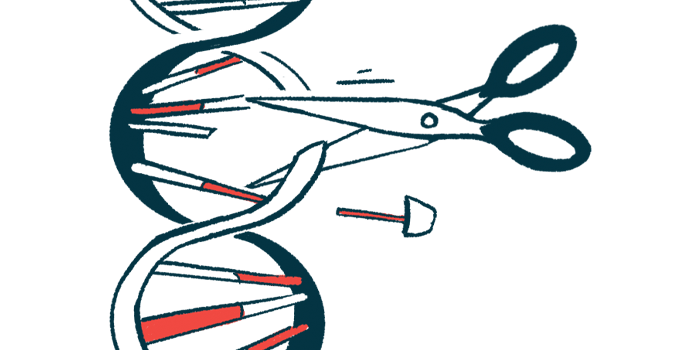Gene-editing therapy for LGMD shows promise in mouse model
Researchers now seeking funding to test approach in clinical trial

A gene-editing therapy designed to correct a defect in the DYSF gene — one that’s associated with a form of limb-girdle muscular dystrophy, or LGMD — was found to restore dysferlin protein levels and help regenerate muscle tissue in a mouse model of the disease.
The researchers are now seeking funding to test the gene-editing approach in a clinical trial.
“We developed a toolbox across cell types and species to translate repair of an important DYSF … mutation,” the researchers wrote. “We suggest that our findings could further advance novel therapies for muscular diseases.”
Among the conditions specifically linked to the DYSF gene is LGMD type 2B/R2, a type of muscular dystrophy (MD) characterized by muscle wasting at the shoulders and hips.
The study, “Gene-editing in patient and humanized-mice primary muscle stem cells rescues dysferlin expression in dysferlin-deficient muscular dystrophy,” was published in the journal Nature Communications.
Gene-editing therapy targets DYSF, whose mutations cause LGMD type 2B/R2
MD refers to a group of disorders characterized by progressively worsening muscle weakness and wasting due to mutations in genes encoding proteins important for muscle health.
Mutations in DYSF, which encodes the production of dysferlin, are the cause of LGMD type 2B/R2. Dysferlin is important for repairing muscle fiber membranes, and its deficiency in LGMD 2B/R2 leads to a progressive loss of muscle function in the hips and shoulders.
“You go from being a good athlete in your teens to being in a wheelchair by 40,” Simone Spuler, MD, a professor at the Experimental and Clinical Research Center (ECRC) of the Max Delbrück Center and Charité – Universitätsmedizin Berlin in Germany, and the study’s senior author, said in a university news story.
According to the researchers, restoring more normal dysferlin levels “is likely the only curative solution” for LGMD. To that end, the team has been working to develop gene-editing tools that can correct disease-driving mutations in DYSF as a way of enabling more normal dysferlin production.
The scientists now have designed a gene-editing therapy to target a common LGMD-causing mutation in DYSF. The therapy utilizes CRISPR/Cas9, a Nobel Prize-winning genome-editing technology developed from the natural defense mechanisms of bacteria.
This study tested the scientists’ novel tool.
First, the team collected muscle stem cells, the precursors to mature muscle cells, from two LGMD patients with the targeted mutation. These cells were then corrected in the lab with the gene-editing therapy.
Data showed that the genetic error could be successfully corrected, with minimal off-target editing in unintended areas of DNA. In turn, the treatment led to the production of a functional dysferlin protein capable of facilitating muscle repair.
To further test the gene-editing approach, the scientists developed a mouse model of LGMD housing the same DYSF mutation as the patient cells. The mice exhibited a lack of dysferlin levels, as well as inflammation and muscle damage consistent with muscular dystrophy.
Muscle stem cells were collected from the mice, then edited in the lab. The cells were then transplanted back into the leg muscles of the mouse model. According to the researchers, this restored dysferlin levels and helped facilitate muscle regeneration.
If therapy works in patients, ‘it will heal the muscle,’ scientist says
Across their experiments, the scientists found that the edited DYSF gene had four changes in its sequence relative to a normal DYSF gene. Nevertheless, it produced a dysferlin protein that behaved very similarly to a normal, or wild-type, dysferlin.
“Even with these four changes, the generated protein is very similar in function to the wild type, which is the version we see in healthy individuals,” said Helena Escobar, PhD, a researcher in Spuler’s lab and the study’s first author.
According to Escobar, the protein “localized along damaged cell membranes and muscle was regenerated.”
No signs of an immune response against the transplanted cells or the dysferlin protein were seen in the mouse model. The scientists noted that this is an important factor when thinking ahead to clinical trials.
We have over 600 muscles in our body. … We are starting very humble [by] targeting one or two muscles. But if this therapy works, it will heal the muscle.
The approach that would be taken in humans would be similar to that in mice, per the scientists. Specifically, muscle cells would be collected from a patient, edited, and then transplanted back into the person’s muscle tissue.
The scientists noted that, right now, the gene-editing therapy would not be a cure; instead, it would help to restore the function of a few key muscles. Studies involving humans would first target perhaps a couple of muscles, according to Spuler.
“We have over 600 muscles in our body and it is not easy to target all of them,” Spuler said. “We are starting very humble with targeting one or two muscles. But if this therapy works, it will heal the muscle.”
According to the researchers, the study’s results “set the stage for … the development of an effective … gene-editing strategy for this as yet untreatable disease.”








